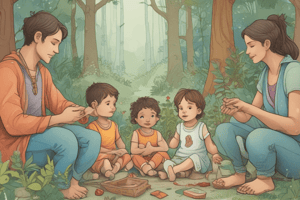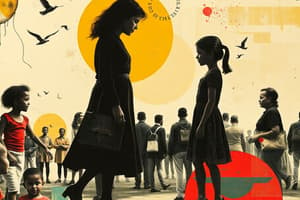Podcast
Questions and Answers
What role do families play in the consultative process according to the information provided?
What role do families play in the consultative process according to the information provided?
- They have direct authority in decision-making.
- Their ideas will definitely be implemented.
- They are consulted but their ideas may not be considered. (correct)
- They are invited to join school bodies.
What type of participation is described as having a direct impact and meaningful involvement?
What type of participation is described as having a direct impact and meaningful involvement?
- Decision-making participation (correct)
- Consultative participation
- Informative participation
- Evaluative participation
What is indicated as a barrier in communication with families?
What is indicated as a barrier in communication with families?
- Limited access to resources
- Lack of shared interests
- Language might be a barrier (correct)
- Cultural differences
When are families most likely to receive invitations to participate in a school body?
When are families most likely to receive invitations to participate in a school body?
Which statement best describes the consultative participation in legal organizations?
Which statement best describes the consultative participation in legal organizations?
In what way can commitment be nurtured according to the content?
In what way can commitment be nurtured according to the content?
What involvement do families have in the student evaluation process?
What involvement do families have in the student evaluation process?
What does flexible approach and plastic participation imply?
What does flexible approach and plastic participation imply?
What does the 'VOICE' concept in Lundy's model emphasize?
What does the 'VOICE' concept in Lundy's model emphasize?
Which aspect of Lundy's model ensures that children's views are communicated to someone who listens?
Which aspect of Lundy's model ensures that children's views are communicated to someone who listens?
What is the primary influence on a child's performance according to Coleman (1972)?
What is the primary influence on a child's performance according to Coleman (1972)?
What is the main premise of Bronfenbrenner's Ecological Systems Theory?
What is the main premise of Bronfenbrenner's Ecological Systems Theory?
How can families contribute to children's education, according to the content?
How can families contribute to children's education, according to the content?
What does the 'INFLUENCE' component of Lundy's model ensure?
What does the 'INFLUENCE' component of Lundy's model ensure?
Which is NOT one of the interconnected systems in Bronfenbrenner's theory?
Which is NOT one of the interconnected systems in Bronfenbrenner's theory?
What is a characteristic of informative family involvement in education?
What is a characteristic of informative family involvement in education?
What is the primary focus of the transformation principle in education?
What is the primary focus of the transformation principle in education?
What does the instrumental dimension of education emphasize?
What does the instrumental dimension of education emphasize?
Which example best illustrates the creation of meaning in education?
Which example best illustrates the creation of meaning in education?
What is meant by the term 'intelligence cultural' as discussed?
What is meant by the term 'intelligence cultural' as discussed?
What does the concept of overcoming the opposition between the humanist and technocratic dimensions of education suggest?
What does the concept of overcoming the opposition between the humanist and technocratic dimensions of education suggest?
Which option best describes the influence of transformative educational experiences?
Which option best describes the influence of transformative educational experiences?
What role do meaningful educational experiences play in a student's achievement?
What role do meaningful educational experiences play in a student's achievement?
How can a teacher effectively align academic content with the curriculum?
How can a teacher effectively align academic content with the curriculum?
What is a fundamental principle of holistic learning for young children?
What is a fundamental principle of holistic learning for young children?
What is emphasized as the starting point for a child's learning according to Froebelian principles?
What is emphasized as the starting point for a child's learning according to Froebelian principles?
How do children learn best according to the principles outlined?
How do children learn best according to the principles outlined?
What is recognized as a key feature of Froebelian education?
What is recognized as a key feature of Froebelian education?
What is the view of childhood in the context of learning?
What is the view of childhood in the context of learning?
Why are relationships considered central in a child's life?
Why are relationships considered central in a child's life?
What role does creativity play in a child's learning process?
What role does creativity play in a child's learning process?
How do symbols impact a child's understanding according to the principles described?
How do symbols impact a child's understanding according to the principles described?
What concept does Froebel's approach emphasize in supporting children's learning?
What concept does Froebel's approach emphasize in supporting children's learning?
Which of the following best describes the 'Gifts' Froebel created?
Which of the following best describes the 'Gifts' Froebel created?
What opportunities do Froebel's Gifts provide for young children?
What opportunities do Froebel's Gifts provide for young children?
How do the Gifts encourage children to connect their learning with the world around them?
How do the Gifts encourage children to connect their learning with the world around them?
What are some characteristics of the Gifts created by Froebel?
What are some characteristics of the Gifts created by Froebel?
What type of play do the Gifts primarily aim to encourage?
What type of play do the Gifts primarily aim to encourage?
Which set of materials is noted as one of the earliest forms of educational tools for young children?
Which set of materials is noted as one of the earliest forms of educational tools for young children?
What is the intended outcome of children using Froebel's Gifts in their play?
What is the intended outcome of children using Froebel's Gifts in their play?
What is the age range for Vocational Training (FP) in the educational system?
What is the age range for Vocational Training (FP) in the educational system?
What was prioritized in the education system established by the General Education Law of 1970?
What was prioritized in the education system established by the General Education Law of 1970?
What significant change occurred in Spanish leadership on November 20, 1975?
What significant change occurred in Spanish leadership on November 20, 1975?
How did the Political Reform Law differ from previous laws under Franco's regime?
How did the Political Reform Law differ from previous laws under Franco's regime?
What was one outcome of the General Education Law regarding gender in education?
What was one outcome of the General Education Law regarding gender in education?
What does Article 2 of the Political Reform Law specify?
What does Article 2 of the Political Reform Law specify?
Which of the following best describes the academic modalities available to students aged 14 to 17?
Which of the following best describes the academic modalities available to students aged 14 to 17?
What was the focus of education during the dictatorship prior to the reforms?
What was the focus of education during the dictatorship prior to the reforms?
Flashcards
Lundy Model of Child Participation
Lundy Model of Child Participation
A model that outlines four key aspects for effective child participation: providing a safe space for expression, ensuring access to relevant information, guaranteeing communication with responsible listeners, and ensuring real action on children's views.
Provide a Safe and Inclusive Space (SPACE)
Provide a Safe and Inclusive Space (SPACE)
Creating a supportive and inclusive environment where children feel comfortable expressing their opinions without fear of judgment or harm.
Provide Appropriate Information and Facilitate Expression (VOICE)
Provide Appropriate Information and Facilitate Expression (VOICE)
Making sure children have access to relevant information about the topic at hand and providing the tools to effectively articulate their views.
Ensure Views are Communicated to Someone Responsible (AUDIENCE)
Ensure Views are Communicated to Someone Responsible (AUDIENCE)
Signup and view all the flashcards
Ensure Views are Taken Seriously and Acted Upon (INFLUENCE)
Ensure Views are Taken Seriously and Acted Upon (INFLUENCE)
Signup and view all the flashcards
Bronfenbrenner's Ecological Systems Theory
Bronfenbrenner's Ecological Systems Theory
Signup and view all the flashcards
Informative Family Involvement
Informative Family Involvement
Signup and view all the flashcards
Impact of Family Education Background
Impact of Family Education Background
Signup and view all the flashcards
School Notice
School Notice
Signup and view all the flashcards
Consultative Participation
Consultative Participation
Signup and view all the flashcards
Decision-Making Participation
Decision-Making Participation
Signup and view all the flashcards
Evaluative Participation
Evaluative Participation
Signup and view all the flashcards
Transformation in Education
Transformation in Education
Signup and view all the flashcards
Instrumental Dimension
Instrumental Dimension
Signup and view all the flashcards
Creating Meaning in Education
Creating Meaning in Education
Signup and view all the flashcards
Cultural Intelligence
Cultural Intelligence
Signup and view all the flashcards
Overcoming the Divide in Education
Overcoming the Divide in Education
Signup and view all the flashcards
Contextual Interactions
Contextual Interactions
Signup and view all the flashcards
Strengths-Based Approach
Strengths-Based Approach
Signup and view all the flashcards
Personal Relevance
Personal Relevance
Signup and view all the flashcards
Unique Learners
Unique Learners
Signup and view all the flashcards
Autonomous Learning
Autonomous Learning
Signup and view all the flashcards
Value of Childhood
Value of Childhood
Signup and view all the flashcards
Importance of Relationships
Importance of Relationships
Signup and view all the flashcards
Creativity and Expression
Creativity and Expression
Signup and view all the flashcards
Power of Symbols
Power of Symbols
Signup and view all the flashcards
Holistic Learning
Holistic Learning
Signup and view all the flashcards
Froebelian Education
Froebelian Education
Signup and view all the flashcards
Froebel's Gifts
Froebel's Gifts
Signup and view all the flashcards
What are Froebel's Gifts made of?
What are Froebel's Gifts made of?
Signup and view all the flashcards
How did Froebel encourage learning through play?
How did Froebel encourage learning through play?
Signup and view all the flashcards
What is Gift 1 in Froebel's Gifts?
What is Gift 1 in Froebel's Gifts?
Signup and view all the flashcards
How do Froebel's Gifts foster learning?
How do Froebel's Gifts foster learning?
Signup and view all the flashcards
What do children do with Froebel's Gifts?
What do children do with Froebel's Gifts?
Signup and view all the flashcards
What is the core principle behind Froebel's Gifts?
What is the core principle behind Froebel's Gifts?
Signup and view all the flashcards
How do Froebel's Gifts help children develop?
How do Froebel's Gifts help children develop?
Signup and view all the flashcards
General Education Law (1970) in Spain
General Education Law (1970) in Spain
Signup and view all the flashcards
Education during the Franco Dictatorship
Education during the Franco Dictatorship
Signup and view all the flashcards
Spanish Constitution of 1978
Spanish Constitution of 1978
Signup and view all the flashcards
Spanish Political Reform Law
Spanish Political Reform Law
Signup and view all the flashcards
Spanish BUP (Unified and Multipurpose High School)
Spanish BUP (Unified and Multipurpose High School)
Signup and view all the flashcards
Spanish COU (University Orientation Course)
Spanish COU (University Orientation Course)
Signup and view all the flashcards
Spanish FP (Vocational Training)
Spanish FP (Vocational Training)
Signup and view all the flashcards
FP (Vocational Training) in Spain
FP (Vocational Training) in Spain
Signup and view all the flashcards
Study Notes
General Information
- Mock exam dates: January 10th (Friday) and June 19th (Friday).
- Exam duration: 2 hours.
- Exam format: 4 questions (2 points each) and 8 multiple choice questions (0.25 points each).
Exam Questions
- What are the 4 main principles of the Convention on the Rights of the Child? (8 points)
- Who was María Montessori and what are the key features of her pedagogical proposal? (8 points)
- Explain the concept of "cultural Intelligence" according to the Dialogic Learning Approach and give examples. (8 points)
- Explain the "Moyano Law." (8 points)
- What are the three Optional Protocols of the Convention on the Rights of the Child about? (Multiple choice, 2 points)
- Which statement best defines María Montessori's approach to education? (Multiple choice, 2 points)
- What are the three levels of education proposed by Claudio Moyano in 1857? (Multiple choice, 2 points)
- What is the significance of unity and connectedness in Fröebel's pedagogy? (Multiple choice, 2 points)
- What are the most effective family involvement options in education? (Multiple choice, 2 points)
- When was the first constitution of Spain approved? (Multiple choice, 2 points)
- In Freire's pedagogy, what is education considered as an act of? (Multiple choice, 2 points)
Studying That Suits You
Use AI to generate personalized quizzes and flashcards to suit your learning preferences.



